DODGE DURANGO 2021 Vehicle Warranty
Manufacturer: DODGE, Model Year: 2021, Model line: DURANGO, Model: DODGE DURANGO 2021Pages: 262, PDF Size: 10.42 MB
Page 61 of 262
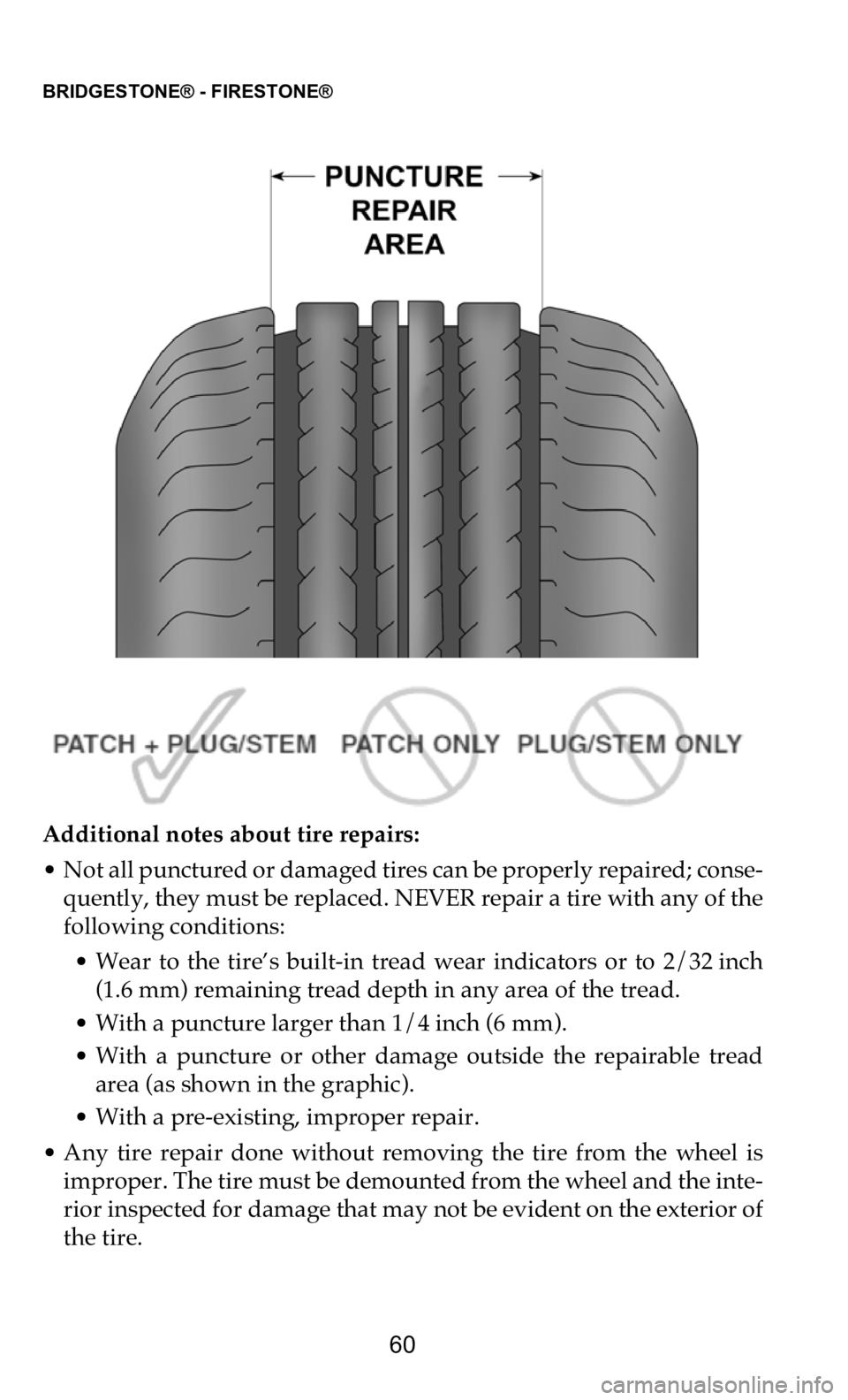
BRIDGESTONE® - FIRESTONE®
60
Additional notes about tire repairs:
• Not all punctured or damaged tires can be properly repaired; conse -
q
uently, they must be replaced. NEVER repair a tire with any of the
fo
llowing conditions:
• Wear to the tire’s built-in tread wear indicators or to 2/32 inch
(1
.6 mm) remaining tread depth in any area of the tread.
• With a puncture larger than 1/4
inch (6 mm).
• With a puncture or other damage outside the repairable tread
a
rea (as shown in the graphic).
• With a pre-existing, improper repair.
•
Any tire repair done without removing the tire from the wheel is
i
mproper. The tire must be demounted from the wheel and the inte -
rior inspected for damage that may not be evident on the exterior of
th
e tire.
Page 62 of 262
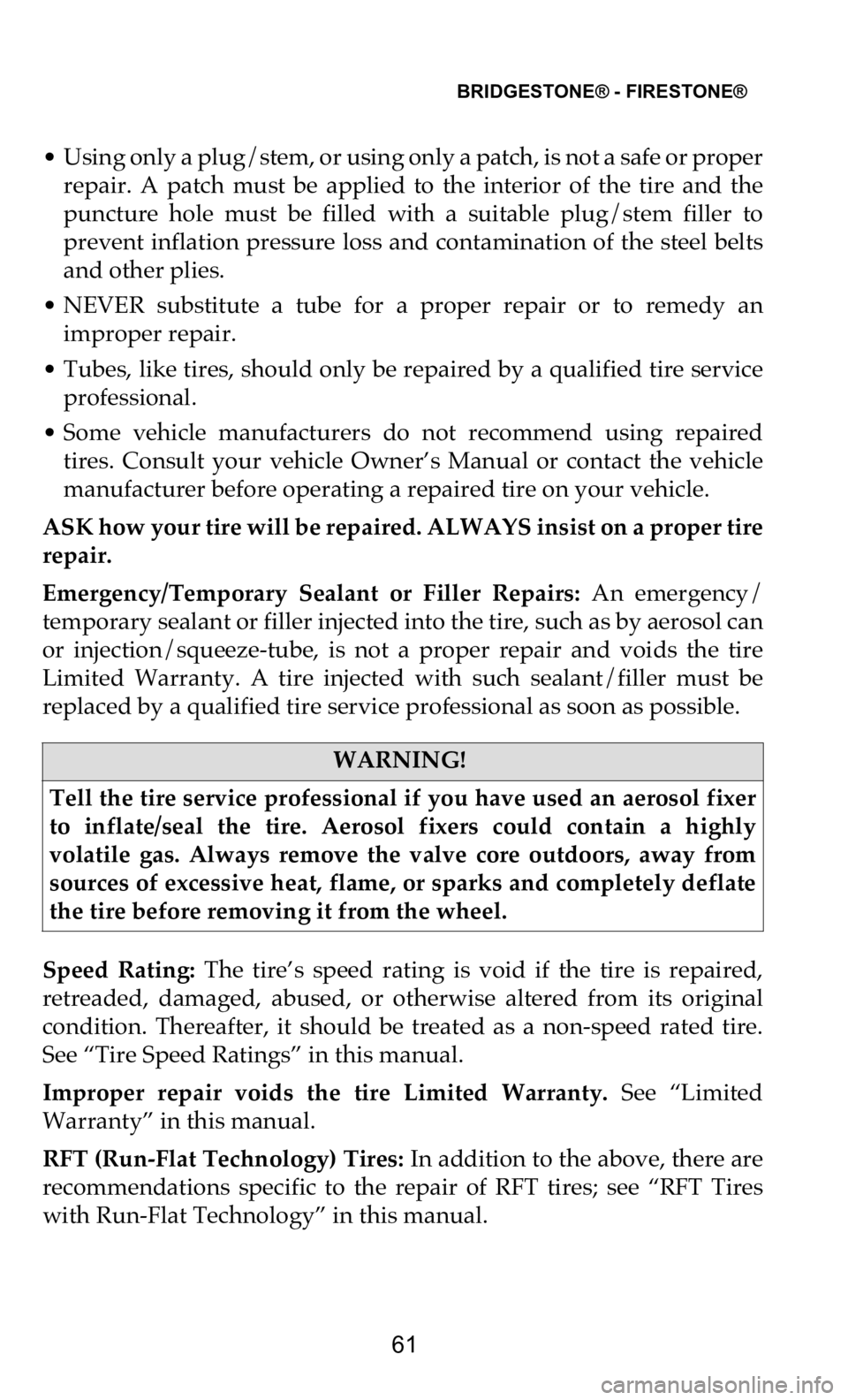
BRIDGESTONE® - FIRESTONE®
61
• Using only a plug/stem, or using only a patch, is not a safe or proper
repair. A patch must be applied to the interior of the tire and the
puncture hole must be filled with a suitable plug/stem filler to
prevent inflation pressure loss and contamination of the steel belts
and other plies.
• NEVER substitute a tube for a proper repair or to remedy an
i
mproper repair.
• Tubes, like tires, should only be repaired by a qualified tire service
p
rofessional.
• Some vehicle manufacturers do not recommend using repaired
t
ires. Consult your vehicle Owner’s Manual or contact the vehicle
manufacturer before operating a repaired tire on your vehicle.
ASK how your tire will be repaired. ALWAYS insist on a proper tire
re
pair.
Emergency/Temporary Sealant or Filler Repairs: A
n emergency/
temporary sealant or filler injected into the tire, such as by aerosol can
or injection/squeeze-tube, is not a proper repair and voids the tire
Limited Warranty. A tire injected with such sealant/filler must be
replaced by a qualified tire service professional as soon as possible.
Speed Rating: T
he tire’s speed rating is void if the tire is repaired,
retreaded, damaged, abused, or otherwise altered from its original
condition. Thereafter, it should be treated as a non-speed rated tire.
See “Tire Speed Ratings” in this manual.
Improper repair voids the tire Limited Warranty. S
ee “Limited
Warranty” in this manual.
RFT (Run-Flat Technology) Tires: I
n addition to the above, there are
recommendations specific to the repair of RFT tires; see “RFT Tires
with Run-Flat Technology” in this manual.
WARNING!
Tell the tire service professional if you have used an aerosol fixer
to
inflate/seal the tire. Aerosol fixers could contain a highly
volatile gas. Always remove the valve core outdoors, away from
sources of excessive heat, flame, or sparks and completely deflate
the tire before removing it from the wheel.
Page 63 of 262

BRIDGESTONE® - FIRESTONE®
62
TIRE MOUNTING AND OTHER SERVICING
This manual is not intended to provide proper training or service
pr
ocedures for tire mounting, demounting, balancing, rotation, or
repair. Please leave these tasks to qualified tire service
professionals. For your safety and that of others:
• Always stand well clear of any tire mounting operation. This is espe -
c
ially important when the service operator inflates the tire. If the tire
ha
s been improperly mounted, it may burst with explosive force
causing serious personal injury or death.
• Tires must match the width and diameter requirements of the
w
heels. For example, 16 inch diameter tires must only be mounted
to
16 inch diameter wheels. Radial tires must only be mounted to
wh
eels approved for radial tires.
• Wheels must be free of cracks, dents, chips, and rust. Tires must be
f
ree of bead damage, cuts, and punctures.
• Never inflate a tire beyond 40 psi (275 kPa) to seat the beads. Be
a
bsolutely certain beads are fully seated before adjusting inflation
pressure to the level recommended for vehicle operation.
• Never put flammable substances in tire/wheel assemblies at any
t
ime. Never put any flammable substance into a tire/wheel
assembly and attempt to ignite to seat the beads.
• Always stand well away from the work area when tires are being
s
pin balanced either on or off the vehicle.
WARNING!
Removing and replacing tires on wheels can be dangerous.
At
tempting to mount tires with improper tools or procedures may
result in a tire explosion causing serious personal injury or death.
This is only a job for a qualified tire service professional. Never
perform tire service procedures without proper training, tools,
and equipment.
Page 64 of 262

BRIDGESTONE® - FIRESTONE®
63
HIGH PERFORMANCE, LOW ASPECT RATIO TIRES
Many new vehicles come equipped from the factory with high
pe
rformance and/or low aspect ratio tires. Generally, these tires
provide increased vehicle handling capability, but may also have
numerous engineering performance trade-offs associated with their
designs.
• Low aspect ratio tires, with reduced sidewall height, may be more
s
usceptible to damage from potholes, road hazards, and other
objects such as curbs. This is true for the wheels as well. Therefore,
as with all other tires, it is important to drive with care and maintain
proper inflation pressure and load conditions. See “Tire Inflation
Pressure” and “Tire Damage, Inspection and Service Life” in this
manual.
• Some sports cars and other handling performance enhanced vehi -
c
les, including sedans and light trucks/SUVs, may be originally
eq
uipped with high performance tires that are more optimized for
warmer weather use. Colder, winter weather traction may be
reduced for these types of tires. Winter tires may be recommended
by the vehicle manufacturer for colder weather application. See
“Winter Tires,” the next section in this manual.
• High performance tires may also wear more quickly, ride more
f
irmly, and produce more noise during operation.
Consult your vehicle Owner’s Manual and tire information placard, or
a
qualified tire service professional, for more information and
specifics regarding these types of tires.
WINTER TIRES
In Winter driving conditions, vehicle control and safe operation under
b r
aking and cornering is especially dependent upon the rear tires. For
this reason, Winter tires are best applied to all wheel positions. Some
WARNING!
Winter driving presents special challenges for vehicle mobility.
Th
e use of winter tires (including studs and chains)—while
improving traction performance in snow and ice—requires special
care with regard to acceleration, braking, cornering, and speed. It
is important to drive with care, not only on snow and ice, but on
dry and wet roads as well.
Page 65 of 262
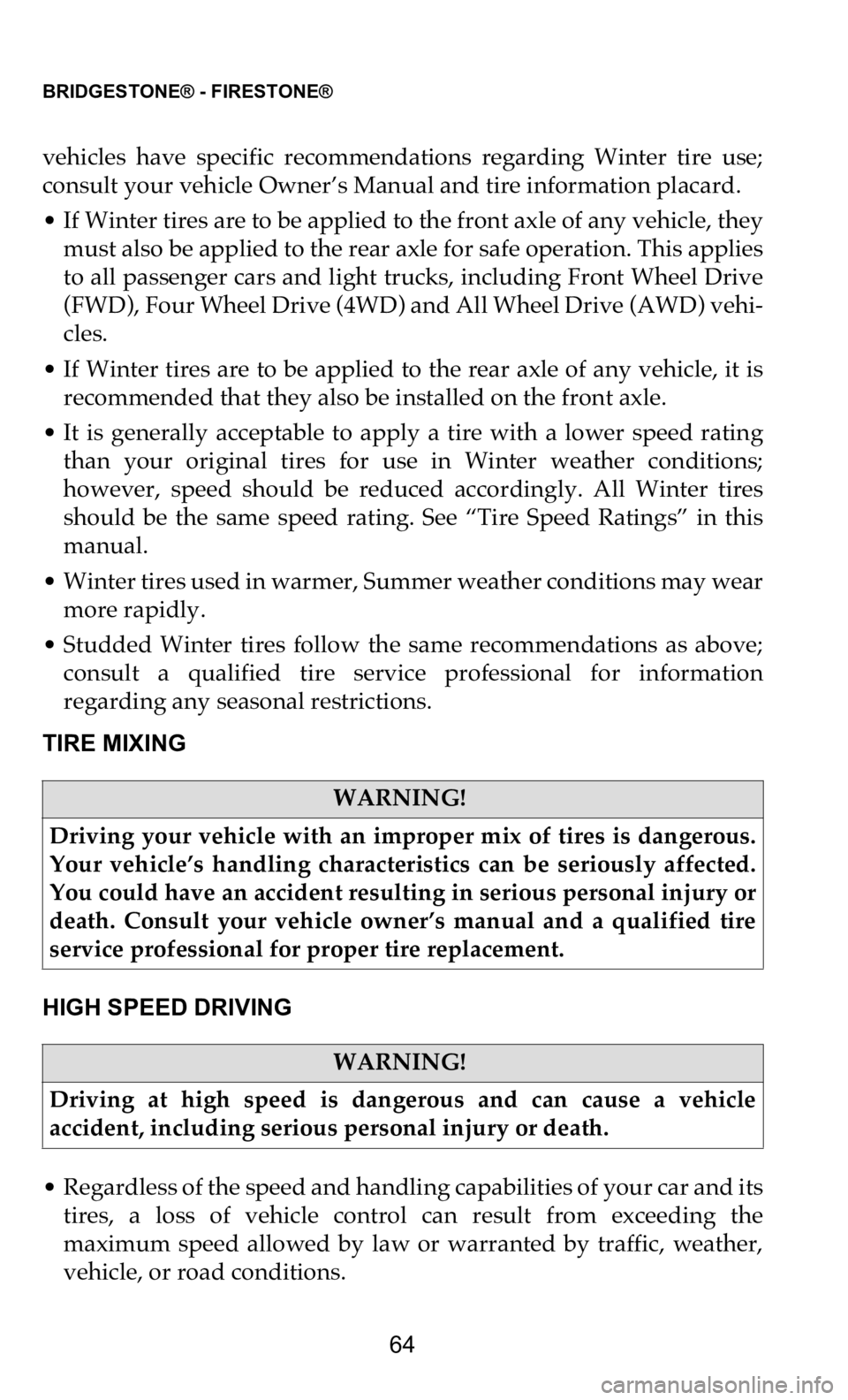
BRIDGESTONE® - FIRESTONE®
64
vehicles have specific recommendations regarding Winter tire use;
consult your vehicle Owner’s Manual and tire information placard.
• If Winter tires are to be applied to the front axle of any vehicle, they
m
ust also be applied to the rear axle for safe operation. This applies
to all passenger cars and light trucks, including Front Wheel Drive
(FWD), Four Wheel Drive (4WD) and All Wheel Drive (AWD) vehi -
cles.
• If Winter tires are to be applied to the rear axle of any vehicle, it is
r
ecommended that they also be installed on the front axle.
• It is generally acceptable to apply a tire with a lower speed rating
t
han your original tires for use in Winter weather conditions;
however, speed should be reduced accordingly. All Winter tires
should be the same speed rating. See “Tire Speed Ratings” in this
manual.
• Winter tires used in warmer, Summer weather conditions may wear
m
ore rapidly.
• Studded Winter tires follow the same recommendations as above;
c
onsult a qualified tire service professional for information
regarding any seasonal restrictions.
TIRE MIXING
HIGH SPEED DRIVING
• R egardless of the speed and handling capabilities of your car and its
t
ires, a loss of vehicle control can result from exceeding the
maximum speed allowed by law or warranted by traffic, weather,
vehicle, or road conditions.
WARNING!
Driving your vehicle with an improper mix of tires is dangerous.
Yo
ur vehicle’s handling characteristics can be seriously affected.
You could have an accident resulting in serious personal injury or
death. Consult your vehicle owner’s manual and a qualified tire
service professional for proper tire replacement.
WARNING!
Driving at high speed is dangerous and can cause a vehicle
ac
cident, including serious personal injury or death.
Page 66 of 262

BRIDGESTONE® - FIRESTONE®
65
• High-speed driving should be left to trained professionals operating
under controlled conditions.
• No tire, regardless of its design or speed rating, has unlimited
c
apacity for speed, and a sudden tire failure can occur if its limits are
exceeded. See “Tire Speed Ratings,” the next section in this manual.
Refer to your vehicle Owner’s Manual for any tire pressure
re
commendations for high speed driving.
TIRE SPEED RATINGS
A tire bearing a letter “speed rating” designation indicates the tire’s
sp
eed capability according to standardized laboratory tests. This
speed rating system is intended to permit comparison of the speed
capabilities of different tires. When replacing your tires, consult your
vehicle Owner’s Manual and tire information placard for
recommendations, if any, concerning the use of speed rated tires.
• To avoid reducing the speed capability of the vehicle, replace a
s
peed rated tire only with another tire having at least the same
speed rating. It is the “top speed” of the “slowest” tire on the vehicle
which limits the vehicle’s top speed without tire failure.
• The tire’s speed rating is void if the tire is repaired, retreaded,
d
amaged, abused, or otherwise altered from its original condition.
Thereafter, it should be treated as a non-speed rated tire.
• Non-speed rated tires are usually for ordinary passenger car or light
t
ruck service and not for high speed driving.
• For winter tires used in cold weather conditions, it is generally
a
cceptable to apply a tire with a lower speed rating than your orig -
inal tires; however, speed should be reduced accordingly. All winter
ti
res should be the same speed rating. Some vehicles have specific
recommendations regarding winter tire use; consult your vehicle
Owner’s Manual and tire information placard. See “Winter Tires” in
this manual.
These speed ratings are based on standardized laboratory tests under
sp
ecific, controlled conditions. While these tests may relate to
performance on the road, real-world driving is rarely identical to any
test conditions. Your tire’s actual speed capability may be less than its
rated speed since it is affected by factors such as inflation pressure,
load, tire condition (including damage), wear, vehicle condition
Page 67 of 262

BRIDGESTONE® - FIRESTONE®
66
(including alignment), driving conditions, and duration at which the
speed is sustained. Use the following chart to compare the speed
ratings of tires.
The tire’s speed rating designation appears on the tire sidewall with
t h
e tire size. Examples:
* In standardized laboratory tests that relate to highway speeds.
Ac
tual tire speed and performance capability depend on factors such
as inflation pressure, load, tire condition, wear, and driving
conditions.
** Any tire having a maximum speed capability above 149 mph
(2
40 km/h) may, at the tire manufacturer’s discretion, include a “Z” in
th
e size designation (i.e. P275/40ZR17).
*** For tires having a maximum speed capability above 186 mph
(3
00 km/h), a “Z” must appear in the size designation and a “Y”
ma
rked in brackets (as shown) in the service description.
**** Consult the tire manufacturer for maximum speed capability.
Speed
Symbol Speed Category*
mph km/h
M 81130
Q 99160
R 106 170
S 112 180
T 118 190
U 124 200
H 130 210
V 149 240
Z** >149 >240
W 168 270
Y 186 300
(Y)** >186
P275/40ZR17 max > 149 mph (240 km/h)****
P275/40R17 93Wmax = 168 mph (270 km/h)
P275/40ZR17 93Wmax = 168 mph (270 km/h)
P275/40ZR17 93Ymax = 186 mph (300 km/h)
P275/40ZR17 93(Y)max > 186 mph (300 km/h)****
Page 68 of 262
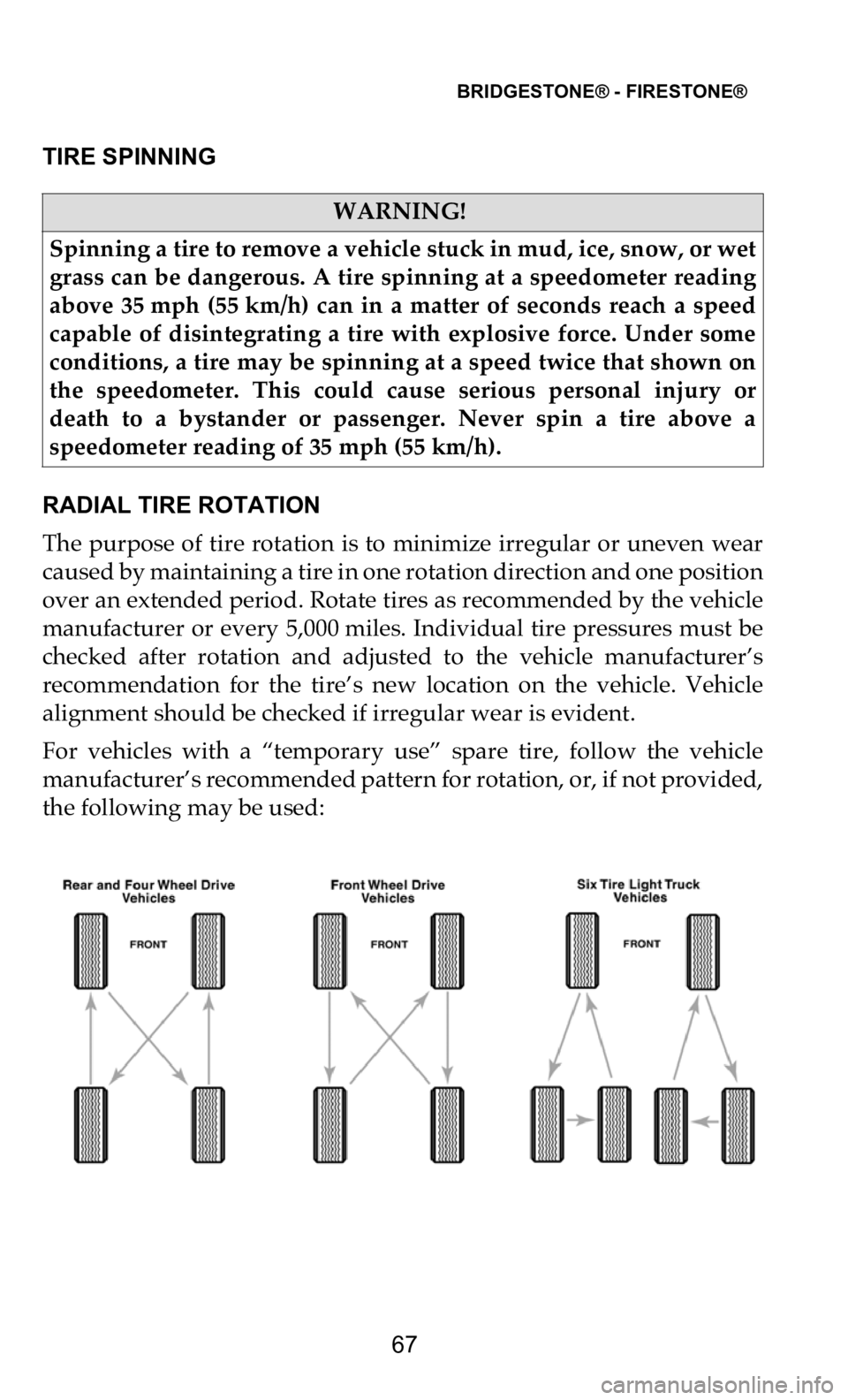
BRIDGESTONE® - FIRESTONE®
67
TIRE SPINNING
RADIAL TIRE ROTATION
The purpose of tire rotation is to minimize irregular or uneven wear
c a
used by maintaining a tire in one rotation direction and one position
over an extended period. Rotate tires as recommended by the vehicle
manufacturer or every 5,000 miles. Individual tire pressures must be
ch
ecked after rotation and adjusted to the vehicle manufacturer’s
recommendation for the tire’s new location on the vehicle. Vehicle
alignment should be checked if irregular wear is evident.
For vehicles with a “temporary use” spare tire, follow the vehicle
ma
nufacturer’s recommended pattern for rotation, or, if not provided,
the following may be used:
WARNING!
Spinning a tire to remove a vehicle stuck in mud, ice, snow, or wet
gr
ass can be dangerous. A tire spinning at a speedometer reading
above 35 mph (55 km/h) can in a matter of seconds reach a speed
ca
pable of disintegrating a tire with explosive force. Under some
conditions, a tire may be spinning at a speed twice that shown on
the speedometer. This could cause serious personal injury or
death to a bystander or passenger. Never spin a tire above a
speedometer reading of 35 mph (55 km/h).
Page 69 of 262
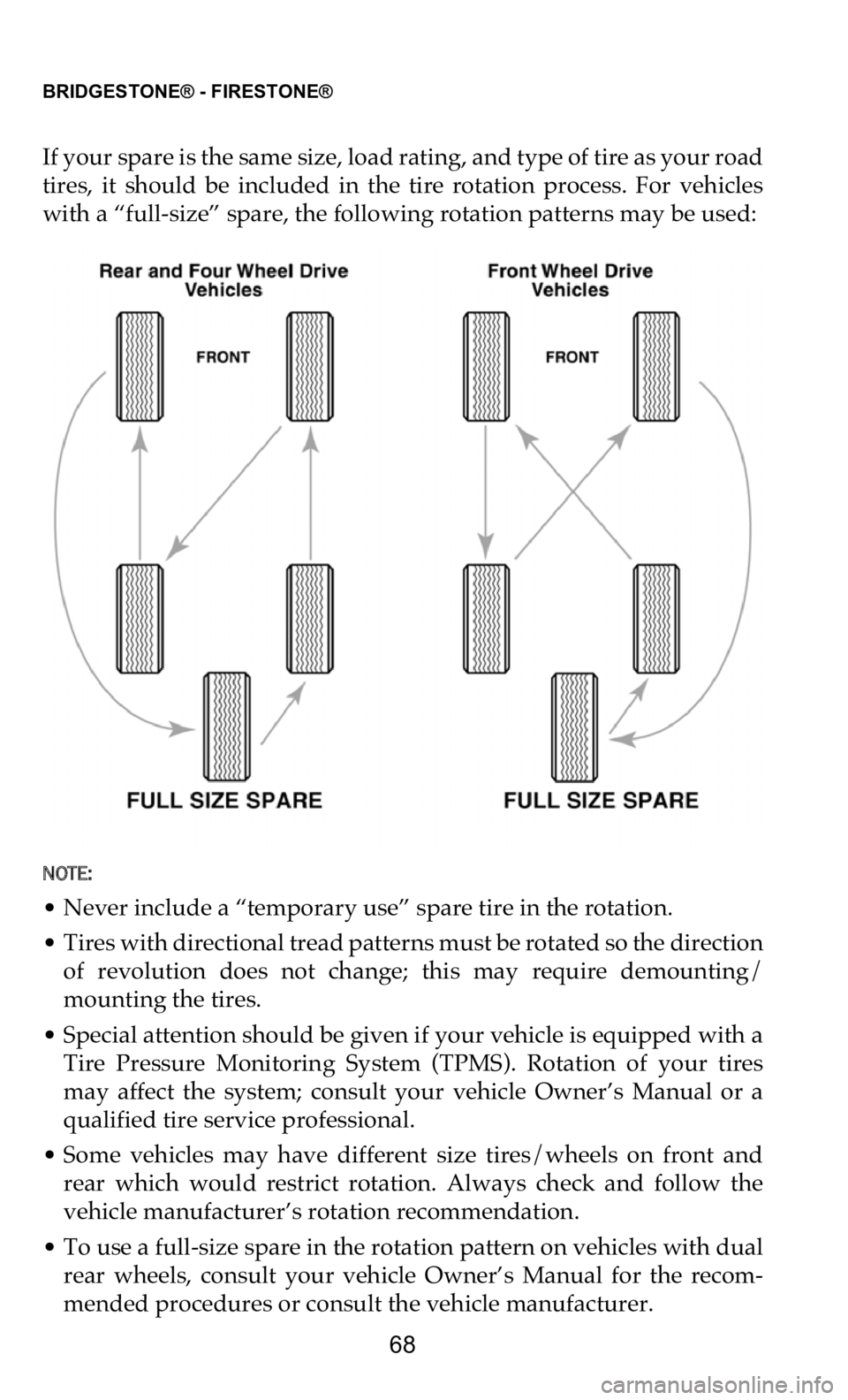
BRIDGESTONE® - FIRESTONE®
68
If your spare is the same size, load rating, and type of tire as your road
tires, it should be included in the tire rotation process. For vehicles
with a “full-size” spare, the following rotation patterns may be used:
NOTE:
• Never include a “temporary use” spare tire in the rotation.
• Tires with directional tread patterns must be rotated so the direction
o
f revolution does not change; this may require demounting/
mounting the tires.
• Special attention should be given if your vehicle is equipped with a
T
ire Pressure Monitoring System (TPMS). Rotation of your tires
may affect the system; consult your vehicle Owner’s Manual or a
qualified tire service professional.
• Some vehicles may have different size tires/wheels on front and
r
ear which would restrict rotation. Always check and follow the
vehicle manufacturer’s rotation recommendation.
• To use a full-size spare in the rotation pattern on vehicles with dual
r
ear wheels, consult your vehicle Owner’s Manual for the recom -
mended procedures or consult the vehicle manufacturer.
Page 70 of 262

BRIDGESTONE® - FIRESTONE®
69
YOUR SPARE TIRE
Consult your vehicle Owner’s Manual for proper application of your
sp
are tire. Your car may be equipped with a “temporary use” spare
tire; this spare may differ in size and construction from the other tires
on your vehicle.
The spare tire in your vehicle is intended to be used as a spare when
n e
eded. The spare tire carrier is not intended to be used for long term
storage, except for “temporary use” tires. If your spare is the same
size, load rating, and type of tire as your road tires, it should be
included in the tire rotation process; see “Radial Tire Rotation” in this
manual for more information.
The spare should be included in regular tire inspections and inflation
pr
essure checks. In addition, it should be replaced 10 years after date
of manufacture, regardless of condition or tread depth. For more
information, see the “Tire Damage, Inspection and Service Life” in this
manual.
TIRE STORAGE
Tires should be stored indoors in a cool, dry place where water cannot
co
llect inside them. Tires should be placed away from electric
generators/motors and sources of heat such as hot pipes. Storage
surfaces should be clean and free of grease, gasoline or other
substances which can deteriorate the rubber.
WARNING!
Check inflation pressure before use. Failure to have proper
in
flation pressure when using your spare tire can result in serious
personal injury or death. See Tire Inflation Pressure in this
manual.
WARNING!
Mounting a “temporary use” tire on a wheel which is not
sp
ecifically designed for it, or placing another type tire on a wheel
designated for temporary use can be dangerous. Your vehicle’s
handling characteristics can be seriously affected. You could have
an accident resulting in serious personal injury or death. Consult
your vehicle owner’s manual for proper application of your
“temporary use” spare tire.